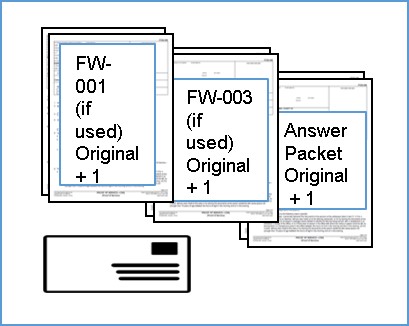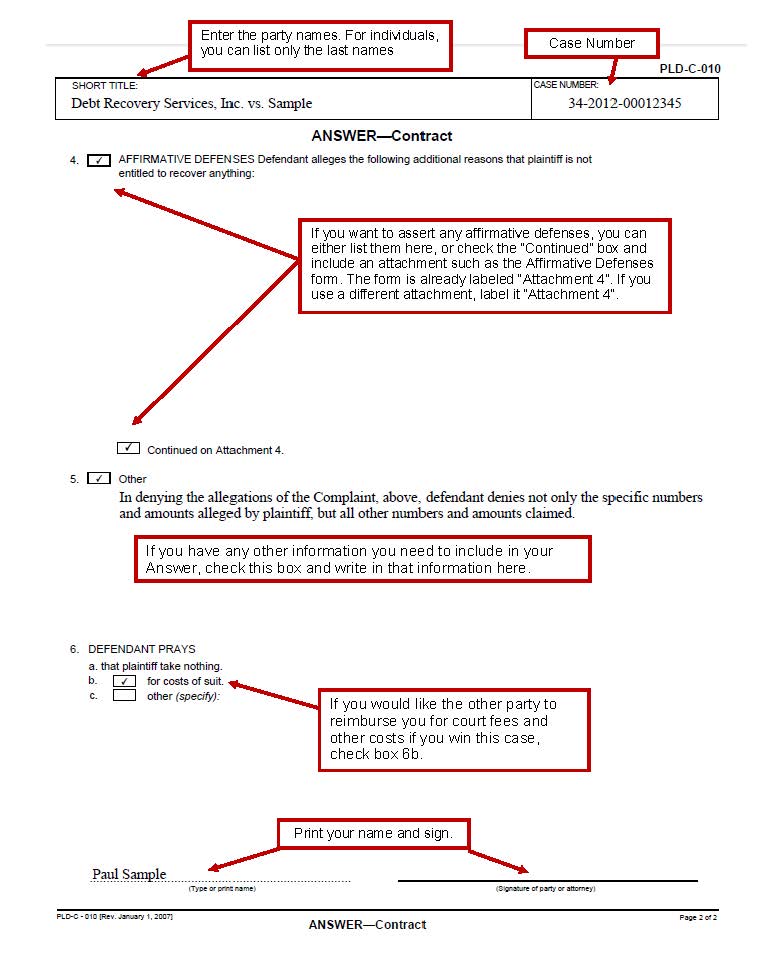Responding to a Debt Collection Lawsuit (Answer-Contract)
When a lawsuit is started against you, you will be served with a Summons and Complaint. Ideally, these will be personally served (delivered to you in person). Service is valid even if you refuse to take them, as long as the server informs you that they are legal documents and leaves them with you, even on the ground.

Templates and Forms
- Answer-Contract (PLD-C-010)
- Affirmative Defense (Attachment 4) – PDF
- Verification: Answer-Contract – PDF
- Request to Waive Court Fees (FW-001)
If the server cannot find you after several attempts, they can leave them at your home or business with an adult, and then mail you a copy. This is called “substituted service” and it is valid as well, as long as they have tried several times to serve you personally first.
These documents formally notify you that a lawsuit has been initiated, and what the lawsuit is about.
You have three basic options once you are sued
1
Respond to the lawsuit
If you believe you have a valid legal defense to this lawsuit and wish to defend yourself, you will need to file a response. There are many methods for responding to this type of lawsuit. One common method is to file an Answer. This Guide provides information about filing an Answer to a Breach of Contract case.
You have 30 days from the day you were personally served to file a written response in proper legal form. If you received the documents by substituted service, you have 40 days after the date the documents were mailed to file a written response in proper legal form. Your 30 (or 40) days start the day after service. If the 30th (or 40th) day falls on a weekend or court holiday, you have until the end of the next business day to file your papers.
2
Allow the plaintiff to obtain a default judgment
Many people who do not have a valid legal defense to this type of case choose not to respond. (Note: not having the money to make payments is NOT a valid legal defense!). If you do not respond to the lawsuit, the other party may get a default judgment against you. This means that the other party wins, and the court will not consider anything you have to say.
Although this may sound bad, for many people it is the quickest, least expensive way to resolve the case. To file a response to the lawsuit, you will have to pay a court filing fee of $225-$435, based on the amount you’re being sued for. (See Sacramento County Superior Court’s fee schedule or your own county court website for the current fee.) Low-income people may qualify for a fee waiver.
If you lose the case, you will be responsible for the other party’s court and attorney fees. If you do not respond and the judgment is obtained by default, these fees are usually less because the attorney has spent less time working on the case. Once a default judgment is entered against you, the plaintiff may begin collection efforts, such as garnishing your wages or levying your bank account. The judgment will appear on your credit report for at least seven years. The judgment can be renewed, and re-reported on your credit report until paid in full
3
Try to negotiate a settlement
You can attempt negotiations at any time during your case. Your negotiations do not automatically stop the lawsuit. The other party can proceed with a default judgment against you unless you file a response with the court. If you attempt negotiations prior to filing a response, you may want to ask the other party for additional time to reply to the lawsuit, in case your negotiations fall through. Be sure any agreement you reach is in writing.
If you reach a settlement, the other party should dismiss your case using a Request for Dismissal (CV-110). The first question on this form indicates if the case is being dismissed “With Prejudice” or “Without Prejudice.” This indicates whether the case may be refiled in the future. “With Prejudice” means the case is permanently dismissed; the plaintiff is waiving the right to refile. This is common if the plaintiff agrees to accept, and the defendant pays, a lump-sum payment. “Without Prejudice” means that the case is dismissed, but the plaintiff reserves the right to refile the case if necessary. This is common if the plaintiff agrees to allow payments over time. If you miss a payment, they may refile the lawsuit.
Make sure the dismissal is entered with the court by checking online. In Sacramento County, civil records are online at the Court’s Public Portal.
Fees and fee waivers
If you decide to respond, you will need to pay a filing fee based on the amount you are being sued for. Your fee is $225 if you are being sued for up to $10,000; $370 if you are being sued for above $10,000 and up to $35,000; and $435 for amounts over $35,000. These fees may change. See Sacramento County Superior Court’s fee schedule or your own county court website for the current fee.
If you cannot afford the fee, you can request a fee waiver using Request to Waive Court Fees (FW-001). If you do, you will not have to pay when you file. If the court denies the fee waiver, you will have to pay after you receive the denial.
If You Decide to Respond….
1
Review the Summons and Complaint
If you believe you have a valid legal defense to this lawsuit and wish to defend yourself, you will need to file a response. There are many methods for responding to this type of lawsuit. One common method is to file an Answer. This Guide provides information about filing an Answer to a Breach of Contract case.
You have 30 days from the day you were personally served to file a written response in proper legal form. If you received the documents by substituted service, you have 40 days after the date the documents were mailed to file a written response in proper legal form. Your 30 (or 40) days start the day after service. If the 30th (or 40th) day falls on a weekend or court holiday, you have until the end of the next business day to file your papers.
2
Fill Out the Necessary Forms
A. Answer Packet
Answer-Contract (PLD-C-010). This is the official fill-in-the-blanks form to answer a breach of contract case. This form may be used in any Superior Court in California.
Affirmative Defenses (Attachment 4). In your Answer, you can present information or evidence that reduces or eliminates your liability, even if the allegations in the complaint are true. These are called “affirmative defenses.”
Affirmative defenses are legal reasons why, even if everything happened just as described by the plaintiff, you should not be held liable. One example of an affirmative defense is that the statute of limitations has run out–that is, the plaintiff’s deadline to file the lawsuit has run out. There many affirmative defenses available.
The Affirmative Defenses attachment 4 form describes the most common defenses to a breach of contract case. After reviewing this form, you may decide that none of the affirmative defenses it describes apply to your case. If you choose not to raise any of these defenses, you do not need this form.
The Sacramento County Superior Court accepts this form when attached to the Answer-Contract (PLD-C-010), but not all courts do. If you want to use this form in a different county, check with the court clerk first to see if they will accept it.
Verification (optional). This is only required if (1) the Complaint demands over $25,000 and (2) the Plaintiff verifies the Complaint. CCP § 446. If you use it, the Verification should be the last page of your Answer.
Combine the Answer-Contract, Affirmative Defenses (if using), and Verification (if using) into one packet (“the Answer Packet”)
Your affirmative defenses must be raised in your Answer, and all facts essential to supporting the particular defense must be included. If you do not raise a particular defense in your Answer, you will be prohibited from using or raising it later on (CCP § 431.30(b)(2)).
B. Proof of Service Form
You will need to have someone — NOT YOU — mail the Answer to the plaintiff before you file it. The person who serves (mails) the Answer Packet for you needs to sign a Proof of Service. You can fill out some of it now. Complete the caption of the form with your name and address, the court’s information, and the names of the plaintiff and defendant(s).
Question 5 asks for the name and address of the person served. Use the name and address on the top left corner of the first page of the Complaint. If the plaintiff is represented by a lawyer, you will be sending it to the lawyer, not the plaintiff themselves.
Your server will complete the rest of this form and sign it. For more information, see our guide on “Service by Mail.”
C. Fee Waiver Request (optional)
If you wish to ask the court to waive court fees, or let you make payments over time, you will need to complete the Request for Fee Waiver (FW-001). For more information, see our guide on Fee Waivers.
3
Make Copies of All Forms
Combine the Answer-Contract (PLD-C-010), Affirmative Defenses (if using), and Verification (if using). Make two copies of that packet. Staple the copies, but leave the original unstapled. One copy will be served on the plaintiff. The original and one copy will be filed in court.
Make one copy of the Proof of Service (POS-030).
Make one copy of the Request to Waive Court Fees (FW-001). The original and one copy will be filed in court.
4
Have someone else serve the papers
Someone over the age of 18 who is not a party to the case – NOT YOU – must serve your documents.
In Step 2, you completed several questions on the Proof of Service form; your server will need to finish the form by adding his or her address and the date and location of mailing. They should not sign this form yet.
In Step 3, you made two copies of your Answer Packet and two copies of your unsigned proof of service. Have the server one copy of each by regular mail (in the same envelope is fine).
You do not need to use certified mail. In fact, if you do, the plaintiff can refuse to take it and your service will fail.
After the server mails the packet, they must fill in any missing information on the Proof of Service, sign the original Proof of Service, and return it to you for filing.
5
Copy the Signed Proof of Service
Make one copy of the signed Proof of Service. Add the original signed Proof of Service to the original Answer Packet (it should be the last page). Staple the copy signed Proof of Service to the back of the copy Answer Packet.
6
Assemble Papers for Filing
After service, you will need to file your documents with the court. The court is very particular about how you file the papers. You need to file the original and one copy of each document. The original will be unstapled in Sacramento, while the copy is stapled. Assemble your packet as follows:

- Request to Waive Court Fees (FW-001) plus one copy, if requesting fees be waived. The original will be unstapled in Sacramento, while the copy is stapled.
- Answer Packet (Answer (PLD-C-010), Affirmative Defenses (if using), Verification, (if using), and signed Proof of Service by Mail (POS-030)) plus one copy. The original will be unstapled in Sacramento, while the copy is stapled.
- OPTIONAL: If you want the court to return a stamped copy, include one extra copy of each document and a self-addressed, stamped envelope. You can also download free copies from the court’s website at any time.
7
Filing and Fees
Your Answer Packet is filed in the drop box in Room 102 in the Sacramento Superior Court at 720 Ninth Street. A supply of binder clips, Civil Document Drop-Off Sheets, and a date stamp are located near the drop box.
Credit cards are not accepted for filing answers.
Fill out and attach the Civil Document Drop-Off Sheet. Date stamp the back of the original packet. Use a binder clip to fasten together the papers; self-addressed stamped envelope, and payment (check or money order) or fee waiver forms. Put this packet into the drop box.
The court will process the paperwork and upload a copy to the court website. If you included an extra copy and self-addressed, stamped envelope, they will also send you copy stamped “Endorsed/Filed.” to the filing party.
What’s Next?
If the defendant files an Answer (or other response), the parties begin the long process of preparing for trial. There will be many more documents to file and serve throughout the lawsuit. For an overview, see our article, “Steps in a Lawsuit.”
For Help
SH@LL (Self-Help at the Law Library)
609 9th Street, Sacramento CA 95814
(916) 476-2731 (Appointment Request Line)
Services Provided: SH@LL provides general information and basic assistance to self-represented litigants on a variety of legal issues. All assistance is provided by telephone. Visit “What we can help with” for a list of qualifying cases.
Eligibility: Must be a Sacramento County resident or have a qualifying case in the Sacramento County Superior Court.
For More Information
At the Law Library:
Win Your Lawsuit KFC 968 .Z9 D86 (Self Help) Chap. 10 Discovery, Chap. 12 Preparing for Trial
Samples


This material is intended as general information only. Your case may have factors requiring different procedures or forms. The information and instructions are provided for use in the Sacramento County Superior Court. Please keep in mind that each court may have different requirements. If you need further assistance consult a lawyer.




